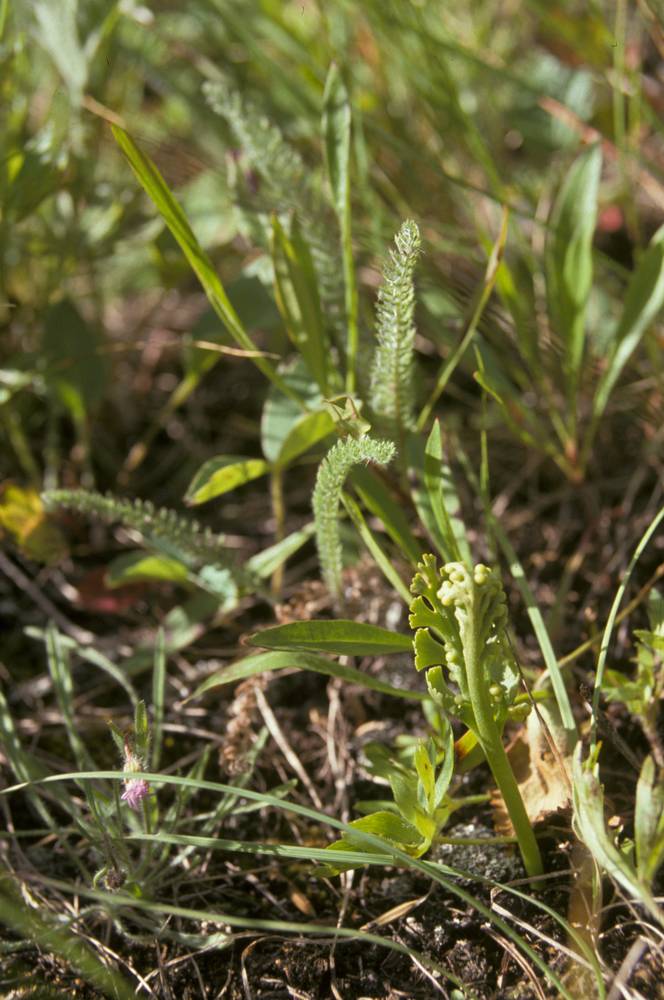Botrychium ascendens
Botrychium paradoxum
upswept moonwort
paradox moonwort
(40)44–47(54) μm.
36– 43 μm.
well developed; greater than 2 cm, green.
well developed; greater than 2 cm, green.
sessile or short-stalked; the stalk occasionally to 2 cm long;
blade 1-pinnate, narrowly oblong-triangular; to 6 × 2 cm, yellow-green and shiny in life;
pinnae to 6 pairs, strongly ascending, narrowly fan-shaped, spanning an arc of less than 90°; broadest at the outer margin, usually coarsely toothed and with 2–5 lobes; lower pinnae often bearing marginal sporangia.
appearing absent, converted entirely to a second sporophore without any trace of lamina.
stiffly erect;
stalk 0.5–1 times as long as the trophophore at spore release, rarely longer;
branches mostly simple, strongly ascending.
stiffly erect, slightly unequal in length, nearly sessile or with stalks up to 50% the entire sporophore length at spore release;
branches much reduced and usually less than 5 mm long, often appearing absent.
=180 (allotetraploid, apparently derived from B. crenulatum and B. lineare).
=180 (allotetraploid, derived; in part; from an undescribed diploid that resembles B. montanum).
Botrychium ascendens
Botrychium paradoxum
Open, well-drained areas and historically disturbed sites with a sparse to dense cover of grasses, forbs, and small shrubs or conifer saplings, such as montane or subalpine meadows, avalanche meadows, road shoulders, ski areas, and mining disturbances. 1500–2000 m. BW. CA, ID, NV, WA; scattered in western and northeastern North America. Native.
Botrychium ascendens is easily confused with B. crenulatum, B. lineare, and B. minganense.
Mesic subalpine meadows, usually among grasses, sedges, and low forbs, but occasionally in denser herbaceous cover or under trees. 1500–1800 m. BW. CA, ID, WA; northwestern North America. Native.
Botrychium paradoxum is unique in having two sporophores and no trophophore. However, other species occasionally produce forms with the trophophore partly or completely transformed into a second sporophore. These usually have sporophores of clearly unequal lengths or with elongate branches, and often occur as isolated individuals among normal, trophophorebearing plants. As currently circumscribed, B. paradoxum contains two distinct genotypes.
Ben Legler
Ben Legler
- Local floras:
BC,
CA,
OR,
WA
- Local Web sites:
CalFlora,
CalPhotos,
Flora NW,
PNW Herbaria
WildflowerSearch
iNaturalist (observations)
USDA Plants Database
- LBJ Wildflower Center
- SEINet
- Plants of the World Online
- Encyclopedia of Life
- Wikipedia
- Google Image Search
- Local floras:
BC,
CA,
OR,
WA
- Local Web sites:
CalFlora,
CalPhotos,
Flora NW,
PNW Herbaria
WildflowerSearch
iNaturalist (observations)
USDA Plants Database
- LBJ Wildflower Center
- SEINet
- Plants of the World Online
- Encyclopedia of Life
- Wikipedia
- Google Image Search




